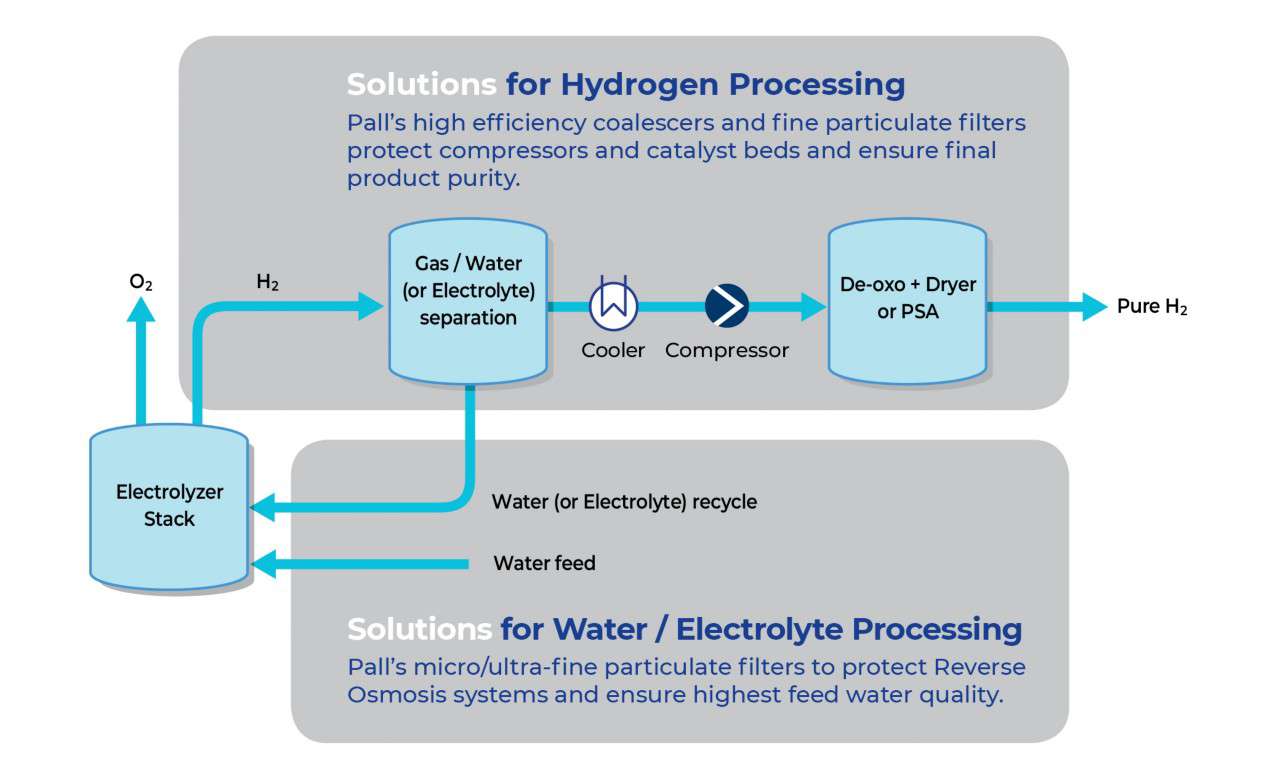Hydrogen produced by the electrolysis of water and when powered by renewable energy sources, such as wind or solar does not result in CO2 emissions and so is the ‘cleanest’ option. 'Green hydrogen' production has been proven to work at a small-scale, but challenges remain in scaling-up production and making it commercially viable.
Filtration and Separation are an essential part of the solution to unlock the potential of this transformational energy source.
Why filtration is critical in green hydrogen production
There are currently three types of electrolyzer technologies being deployed. The alkaline, the polymer electrolyte membrane, and the solid oxide electrolyzers. Regardless of the technology used, filtration is critical to Hydrogen production:
- Operational Lifetime of Electrolyzer: Solids present in the incoming water feed can impact electrolyzer performance and operational lifetime
- Performance of Compressor: Post-hydrolysis, the liquids in the product stream can cause problems in downstream equipment. Compressor performance is linked to the degree of cleanliness of the gas.
- Impact of End-Use-Applications: Solid contaminants originating from process piping or drier beds can affect subsequent processes and end-use applications
Green Hydrogen Purification Challenges:
The technical challenge lies in purifying the hydrogen stream produced as the specifications around Hydrogen gas purity are extremely stringent. Concentrations of between 2,000-6,000 ppm (parts per million) of oxygen and more than 2,000 ppm of water are typically seen in produced hydrogen streams yet the maximum concentration recommended in international standard ISO 14687:2019 for hydrogen fuel cells is 5 ppm of each. Ensuring an oil-free stream post-compression is also critical to meet fuel cell specifications. Hence, several filtration, separation and purification process steps are needed to achieve the required purity levels.
How Can Pall’s Advanced Filtrations Solutions for Green Hydrogen Production help:
The choice of separation equipment is influenced by factors such as quality needed, flow rate and types of contamination. Pall experts can conduct a thorough review, including lab testing and field trials to fully understand the problem and where to integrate the separation technology. With Pall’s advanced technology, you can be rest assured that your filtration solutions will be optimized for run length, size and flow rate - thereby bringing down your production costs significantly.
Typical Green Hydrogen Production process and Pall’s Solutions
Hydrogen Processing Solutions:
Pall's high efficiency coalescers and particulate filters protect compressors and catalyst beds and ensure final product purity.
Water/Electrolyte Processing:
Pall’s micro/ultra-fine particulate filters to protect reverse-osmosis systems and ensure highest feed water quality.
As a global leader in filtration technology and solutions, we understand that one solution cannot fit all. Our experts will provide bespoke solutions tailored to your needs in partnership with you. To find out more, contact us.
For more information on improving the efficiency of your processes, contact our team of filtration experts.
Pall in the Press
Read our articles featured in leading titles in the industry trade press
Hydrogen Power : Why filtration is the key to a green energy future Filtration+Separation, Mar '22






